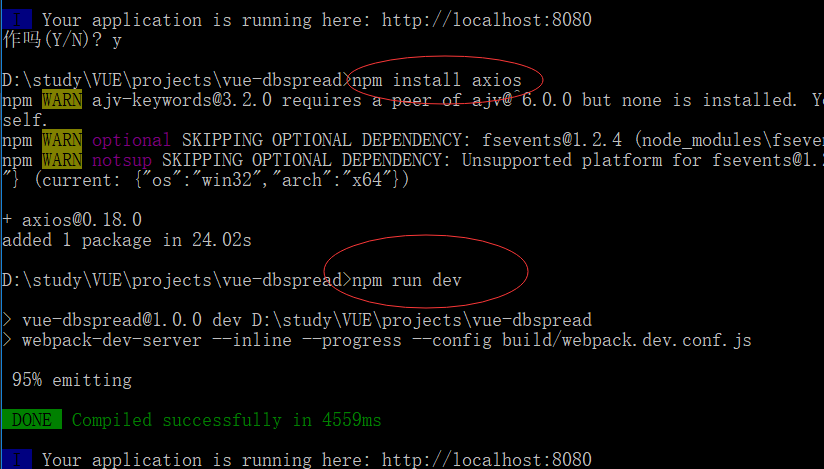VUE系列三:实现跨域请求(fetch/axios/proxytable)
1. 在 config/index.js 配置文件中配置proxyTable
'use strict' // Template version: 1.3.1 // see http://vuejs-templates.github.io/webpack for documentation. const path = require('path') module.exports = { dev: { // Paths assetsSubDirectory: 'static', assetsPublicPath: '/', proxyTable: { '/apis': { // 测试环境 target: 'http://www.thenewstep.cn/', // 接口域名 changeOrigin: true, //是否跨域 pathRewrite: { '^/apis': '' //需要rewrite重写的, } } }, // Various Dev Server settings host: 'localhost', // can be overwritten by process.env.HOST port: 8080, // can be overwritten by process.env.PORT, if port is in use, a free one will be determined autoOpenBrowser: false, errorOverlay: true, notifyOnErrors: true, poll: false, // https://webpack.js.org/configuration/dev-server/#devserver-watchoptions- /** * Source Maps */ // https://webpack.js.org/configuration/devtool/#development devtool: 'cheap-module-eval-source-map', // If you have problems debugging vue-files in devtools, // set this to false - it *may* help // https://vue-loader.vuejs.org/en/options.html#cachebusting cacheBusting: true, cssSourceMap: true }, build: { // Template for index.html index: path.resolve(__dirname, '../dist/index.html'), // Paths assetsRoot: path.resolve(__dirname, '../dist'), assetsSubDirectory: 'static', assetsPublicPath: '/', /** * Source Maps */ productionSourceMap: true, // https://webpack.js.org/configuration/devtool/#production devtool: '#source-map', // Gzip off by default as many popular static hosts such as // Surge or Netlify already gzip all static assets for you. // Before setting to `true`, make sure to: // npm install --save-dev compression-webpack-plugin productionGzip: false, productionGzipExtensions: ['js', 'css'], // Run the build command with an extra argument to // View the bundle analyzer report after build finishes: // `npm run build --report` // Set to `true` or `false` to always turn it on or off bundleAnalyzerReport: process.env.npm_config_report } }
2. fetch实现跨域请求
在根组件App.vue里面发送请求
// 1. 模板:html结构 有且只有一个根标签 <template> <div id="app"> <!-- 使用路由实现跳转 注意:to里面写的是路由的名字 --> <ul> <li><router-link to="/">home</router-link></li> <li><router-link to="/Users">Users</router-link></li> </ul> <!-- 进入首页默认加载的路由 --> <router-view></router-view> </div> </template> //2. 行为:处理逻辑 <script> export default { name: 'App',//组件App.vue的名字 data () { return { } }, //实现跨域请求 created(){ //fetch实现跨域请求 fetch("/apis/test/testToken.php",{ method:"POST", headers:{ token:"f4c902c9ae5a2a9d8f84868ad064e706" }, body:JSON.stringify({username:"lgs",password:"123"}) }).then(result=>{ // console.log(result) //解析数据 return result.json() }).then(data =>{ //打印数据 console.log(data); }) } } </script> //3. 样式:解决样式 <style scoped> h1 { color:purple; } </style>
响应结果:

3. axios实现跨域请求
3.1 停止项目,安装axiosnpm install axios,然后重启项目npm run dev

3.2 在main.js里面引入axios,配置全局使用axios,设置token和请求头
// The Vue build version to load with the `import` command // (runtime-only or standalone) has been set in webpack.base.conf with an alias. import Vue from 'vue' //导入vue import VueRouter from 'vue-router' //引入路由 import VueResource from 'vue-resource' //引入vue-resource import axios from 'axios' //引入axios import App from './App' //导入根组件App.vue import Users from './components/Users'//导入组件Users.vue import Home from './components/Home'//导入组件Users.vue //全局使用axios Vue.prototype.$axios = axios //设置token axios.defaults.headers.common['token'] = "f4c902c9ae5a2a9d8f84868ad064e706" //设置请求头 axios.defaults.headers.post["Content-type"] = "application/json" Vue.config.productionTip = false //引入路由后使用路由,这样就可以在任何组件中使用路由了 Vue.use(VueRouter) //引入vue-resource后使用vue-resource,这样就可以在任何组件中使用http了 Vue.use(VueResource) //配置路由 const router = new VueRouter( { routes : [ //配置路由跳转到Home这个组件 {path:"/",component:Home}, //配置路由跳转到Users.vue这个组件 {path:"/Users",component:Users} ], //去掉地址栏的"/#/" mode : "history" } ) /* eslint-disable no-new */ new Vue({ //实例化一个vue对象 router,//使用路由 el: '#app', //index.html的根元素app components: { App },//注册根组件App.vue才能使用 template: '<App/>'//VUE模板使用,可以是组件、html标签等 })
3.2 在根组件App.vue里面发送请求
// 1. 模板:html结构 有且只有一个根标签 <template> <div id="app"> <!-- 使用路由实现跳转 注意:to里面写的是路由的名字 --> <ul> <li><router-link to="/">home</router-link></li> <li><router-link to="/Users">Users</router-link></li> </ul> <!-- 进入首页默认加载的路由 --> <router-view></router-view> </div> </template> //2. 行为:处理逻辑 <script> export default { name: 'App',//组件App.vue的名字 data () { return { } }, //实现跨域请求 created(){ //fetch实现跨域请求 // fetch("/apis/test/testToken.php",{ // method:"POST", // headers:{ // token:"f4c902c9ae5a2a9d8f84868ad064e706" // }, // body:JSON.stringify({username:"lgs",password:"123"}) // }).then(result=>{ // // console.log(result) // //解析数据 // return result.json() // }).then(data =>{ // //打印数据 // console.log(data); // }) //axios实现跨域请求 this.$axios.post("/apis/test/testToken.php",{ username:"lgs",password:"123" }).then(data=>{ console.log(data) }) } } </script> //3. 样式:解决样式 <style scoped> h1 { color:purple; } </style>
响应结果:





